Chapter 2 - Chromosomes and Chromosomal Transmission
1/83
Earn XP
Name | Mastery | Learn | Test | Matching | Spaced |
|---|
No study sessions yet.
84 Terms
Mitosis
Nuclear division that generates two daughter cells containing the same number and type of chromosomes as the parent cell.
Meiosis
Nuclear division that generates gametes (egg and sperm) containing half the number of chromosomes found in other cells.
Chromosomes
Structures within living cells that contain the genetic material (genes). Biochemically, they also contain DNA, proteins, chromatin, and non-coding RNAs.
Chromatin
A DNA-protein complex found in eukaryotes along with non-coding RNAs.
Prokaryotes
Bacteria and archaea fall under this cell type.
Eukaryotes
Protists, fungi, plants, and animals fall under this cell type.
1) Don’t contain a nucleus
2) Contain a single circular chromosome within a region of the cytoplasm called the nucleoid
3) Cytoplasm enclosed by a plasma membrane that regulates nutrient uptake and waste excretion
4) Plasma membrane is enclosed by a rigid cell wall for protection from breakage
5) May contain an outer membrane and flagellum
What are distinctive characteristics of prokaryotes?
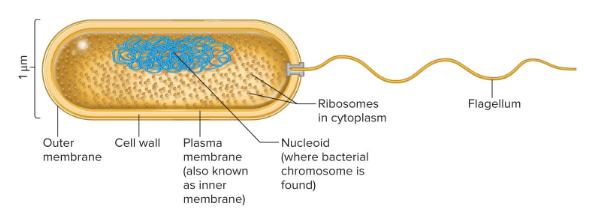
1) Have a membrane-bound nucleus that contains the genetic material in the form of linear chromosomes
2) Have membrane bound organelles with specific functions (i.e. mitochondria, lysosomes, and golgi apparatus)
What are distinctive characteristics of eukaryotic cells?

Mitochondria
An organelle that contains its own DNA and plays a part in ATP synthesis.
Lysosomes
Organelles that play a role in degradation of macromolecules.
Golgi Apparatus
An organelle that plays a role in protein modification and trafficking.
Somatic cells
Animal cells that comprise an organism’s body cells besides gametes.
Ex) Blood cells
Germ Cells
The second type of animal cell. Gametes.
Ex) Sperm and egg
Cytogenetics
The field of genetics that involves the microscopic examination of chromosomes. One in this field will often examine the chromosomal composition of a particular cell or organism, allowing for the detection of individuals with abnormal chromosome numbers or structures. This field also provides a way to distinguish between two closely-related species.
Diploid (2n) / haploid (n)
Fill in the blank…
Most body cells are ( ), meaning each chromosome pair has one maternal and one paternal copy. In meiosis, ( ) cells are produced
Ex) Humans → 2n = 46 and n = 23
Eukaryotic
Fill in the blank…
Most ( ) species are diploid and have two sets of chromosomes.
Ex) Dogs → 79 total chromosomes (39 per set)
Homologs
Members of a pair of chromosomes.
Homologous Pair
The two homologs in a chromosome pair. They are nearly identical in size, have the same banding pattern and centromere location, and have the same genes, but not necessarily the same alleles.
1 / allelic
Fill in the blank…
The DNA sequences on homologous chromosomes are very similar. There is usually less than ( )% difference between homologs. Nevertheless, these slight differences in DNA provide the ( ) differences in genes.
Ex) Brown vs. blue eyes
Sex / homology
Fill in the blank…
The ( ) chromosomes are not homologous, so they differ in size and genetic composition. They do, however, have short regions of ( ).
Locus
The physical location of a gene on a chromosome. This is the same in homologous chromosomes.

Homozygous for dominant allele
AA
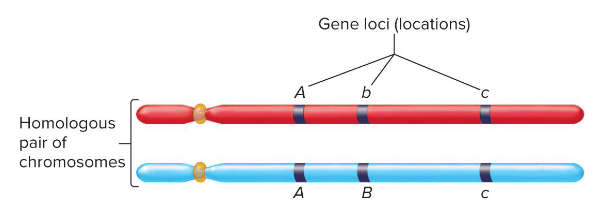
Heterozygous
Bb

Homozygous for the recessive allele
cc

Metacentric Chromosomes
Chromosomes whose centromere is in the middle.
Acrocentric Chromosome
Chromosomes whose centromere is near one end.
1) Asexual reproduction
2) Achieving multicellularity
What are two main purposes for cell division?
Binary Fission
The process by which bacteria divide. Before the process begins, the cell replicates its chromosome. This process then divides the cell into two daughter cells. This process does not involve the genetic contributions from two different gametes.
To complete the process, a FtsZ protein recruits other proteins to create a new cell wall that separates the two daughter cells.

Cell Cycle
A series of stages eukaryotic cells go through when they are destined to divide.

Interphase
This stage of the cell cycle is comprised of G1 (Gap 1), S, and G2 (Gap 2)
G0
A phase of the cell cycle in which a cell may reside for long periods of time. A cell in this phase has either postponed progress through the cell cycle or made the decision to never divide again (i.e. adult nerve cells)
G1
This phase of the cell cycle occurs when the cell prepares to divide. It reaches a restriction point and is committed to a pathway to cell division.
S
This phase of the cell cycle occurs when the chromosomes of a cell are replicated and the two copies are joined at the centromere.
Chromatids
The two copies of the replicated chromosome in the S phase.

Sister Chromatids
Also called a dyad. This structure contains the two chromosome copies joined together at the centromere.
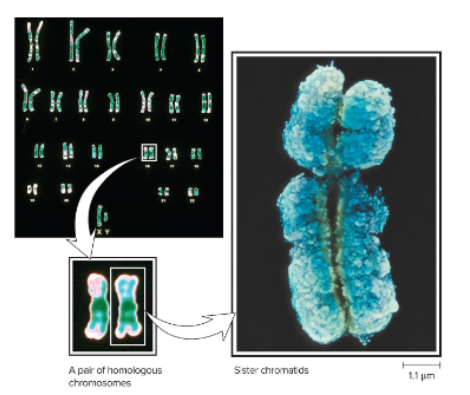
Chromatids
Fill in the blank…
At the end of S phase, a cell has twice as many ( ) as there are chromosomes in the G1 phase.
Ex) In humans, there are 46 chromosomes in the G1 phase and 46 sister chromatid pairs (92 chromatids) after the S phase.
Chromatid / sister chromatids
Fill in the blank…
The term chromosome is relative. In G1 and late M phase, a chromosome is the equivalent of one ( ). In G1 and early M phase, it is a pair of ( ).
Ex) Humans → 46 chromosomes at all stages of the cycle.
G2
This phase of the cell cycle occurs when the cell accumulates the materials that are necessary for nuclear and cell division.
M
This phase of the cell cycle is where mitosis occurs. The primary purpose of this phase is to distribute the replicated chromosomes to the two daughter cells.
Ex) 46 pairs of sister chromatids (92 chromatids) are separated and sorted so that each daughter cell receives 46 chromosomes (aka chromatids)
1) Prophase
2) Prometaphase
3) Metaphase
4) Anaphase
5) Telophase
What are the five phases of mitosis?
Chromosomes / centrosome
Fill in the blank…
Consider an example of mitosis in which the original mother cell is diploid and contains six total chromosomes (chromatids). In interphase, the chromosomes decondense and by the end, the chromosomes are replicated, producing twelve ( ) (chromatids). The ( ), or the attachment point of the mitotic spindle, divides.

Aster Microtubules
A type of spindle microtubule that is important for positioning the spindle apparatus.

Polar Microtubules
A type of spindle microtubule that helps push the poles away from each other.

Kinetochore Microtubules
A type of spindle microtubule that attach to the kinetochore, which is bound to the centromere of each individual chromosome.

Prophase
The first phase of mitosis in which the nuclear envelope dissociates into small vesicles. The chromatids condense into more compact structures and the centrosomes begin to separate.
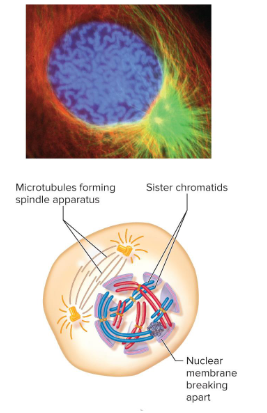
Prometaphase
The second phase of mitosis in which the centrosomes move to opposite ends of the cell, forming the spindle poles. The spindle fibers interact with the sister chromatids and the spindle apparatus forms. Kinetochore microtubules grow from the two poles.
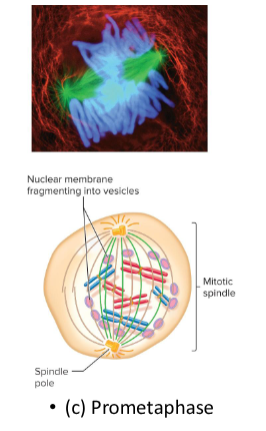
Captured / depolymerizes
Fill in the blank…
In prometaphase, the kinetochore microtubules grow from the two poles. If they make contact with a kinetochore (centromere), the sister chromatid is ( ). If not, the microtubule ( ) and retracts to the centrosomes.
Opposite
Fill in the blank…
In prometaphase, the two kinetochores on a pair of sister chromatids are attached to microtubes on ( ) poles.
Metaphase
The third phase of mitosis in which the pairs of sister chromatids align themselves along a plane called the metaphase plate. Each pair of chromatids is attached to both poles by kinetochore microtubules in the previous phase.
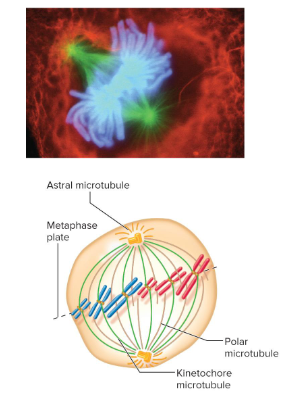
Anaphase
The fourth phase of mitosis in which the connection holding the sister chromatids together is broken. Each chromatid, now an individual chromosome, is linked to only one pole. As this phase proceeds, the kinetochore microtubules shorten and the chromosomes move to opposite poles. Additionally, polar microtubules lengthen and move further away from each other.

Telophase
The final phase of mitosis in which chromosomes reach their respective poles and decondense. The nuclear membrane reforms to form two separate nuclei.
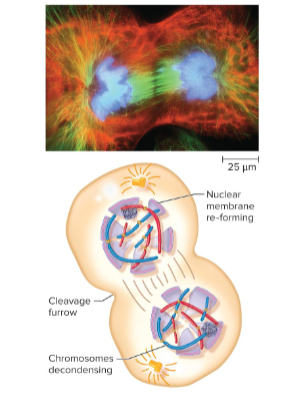

Cytokinesis
A process that occurs quickly after mitosis. In animals, this involves the formation of a cleavage furrow. In plants, this involves formation of a cell plate.

Production of two identical daughter cells having the same number and complement of chromosomes as the mother cell
What is the outcome of mitotic cell division?
Meiosis
Sexual reproduction relies on this cellular division process. During this process, parents that are diploid make gametes that have half the amount of genetic material (haploid). These gametes will later fuse with one another during fertilization to produce a diploid organism.
To produce haploids, this process must correctly sort and distribute chromosomes in order for the daughter cell to receive half the amount of chromosomes and receive one of each chromosome pair.
Similarity → Meiosis begins after a cell has progressed through interphase of the cell cycle
Difference → It involves two successive divisions to reduce chromosome content
What are similarities and differences between mitosis and meiosis?
1) Leptotene
2) Zygotene
3) Pachytene
4) Diplotene
5) Diakinesis
What are the five phases of phophase 1 during meiosis?
Leptotene
In this stage of prophase 1 in meiosis, the replicated chromosomes condense and the centrosomes begin to expand.
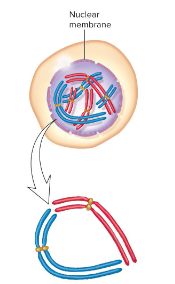
Zygotene
In this stage of prophase 1 in meiosis, synapsis of chromosomes begins in which chromosomes begin to fuse with one another.

Pachytene
In this stage of prophase 1 in meiosis, a bivalent chromosome has formed and crossing over has occurred (regions of one chromosome switch with the regions of another)

Diplotene
In this stage of prophase 1 in meiosis, the synaptonemal complex dissociates.
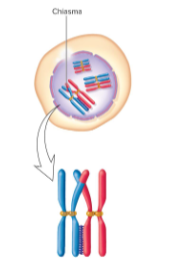
Diakinesis
In this stage of prophase 1 in meiosis, the nuclear membrane breaks apart and prophase 1 ends.

Prometaphase 1
During this phase of meiosis 1, the bivalent chromosomes become attached to the kinetochore microtubules at opposite poles (one microtubule attached to each dyad in the tetrad) and the nuclear membrane starts to condense into vesicles.
Metaphase 1
During this phase of meiosis 1, the bivalent chromosomes line up along the metaphase plate.
Anaphase 1
During this phase of meiosis 1, each dyad in the bivalent chromosomes are pulled towards opposite ends of the cell as the kinetochore microtubules shorten and the polar microtubules lengthen.
Telophase 1
By the end of this phase of meiosis 1, each cell has half the amount of pairs of sister chromatids (dyads) as during the start of prophase 1.
Mitosis / meiosis 2
Fill in the blank…
The sorting events that occur during meiosis 2 are similar to those that occur during mitosis. However, as an example, ( ) begins with 12 chromatids joined as six pairs of sister chromatids. ( ) beings with 6 chromatids joined as three pairs of sister chromatids.
Half
Mitosis and meiosis 2 are similar except that meiosis 2 starts with ( ) the genetic material.
Mitosis produces 2 diploid daughter cells while meiosis produces four haploid daughter cells
Mitosis produces daughter cells that are genetically identical while meiosis produces cells that are not
What are differences between mitosis and meiosis?
Sister chromatids / bivalents
Fill in the blank….
Mitosis and meiosis 2 align and separate ( ) in metaphase and anaphase while meiosis 2 align and separate ( ).
Both / one
Fill in the blank…
During prometaphase, in mitosis and meiosis 2, a pair of sister chromatids is attached to ( ) poles (one chromatid to each pole) via the microtubules while during meiosis 1, they are attached to only ( ) pole (one pair to each pole).
Gametogenesis
The process by which diploid parents make gametes with half the amount of genetic material (haploids).
Isogamous
A characteristic of simple eukaryotic species in which they produce gametes that are morphologically similar.
Ex) Fungi and algae
Heterogamous
A more common characteristic of eukaryotes in which they produce gametes that are morphologically different.
Ex) Sperm is small and mobile while eggs are large, nonmobile, and store a large amount of nutrients compared to other cells
Spermatogenesis
The process of sperm production that starts with a diploid primary spermatocyte. Following meiosis 1 and 2, spermatids then mature haploid sperm cells are produced. This is a continuous process in males, enabling males to produce several hundred million sperm per day.

Acrosome
A cap on the sperm head that contains digestive enzymes that enable sperm to penetrate the protective layers of the egg.
1) Long flagellum
2) A head (contains a haploid nucleus)
What are the two main structures of a sperm cell?
Oogenesis
The production of egg cells in females that occurs in the ovaries. Early in development, diploid oogonia produce diploid primary oocytes that initiate meiosis 1. They are, however, arrested in prophase 1 until the female becomes sexually mature.
At puberty, the primary oocytes are periodically activated to progress through meiosis 1. Only one cell per meiosis becomes an egg since division is asymmetric, producing two haploid cells of unequal size.
The large cell is the secondary oocyte while the small is a polar body. The secondary oocyte enteres meiosis 2 and is released into the oviduct in the process of ovulation.
If fertilization occurs, meiosis 2 is completed and produces a haploid egg and small polar body. The haploid egg and sperm nuclei then fuse to produce a diploid nucleus.

Asymmetric / cytoplasm
Fill in the blank…
Unlike spermatogenesis, the divisions in oogenesis are ( ) and produce polar bodies that contain very little ( ).

Heterogametic
Sexually reproducing organisms that produce and transmit two different sex chromosomes.
Ex) Males produce X and Y chromosomes. The Y chromosome determines maleness in humans.
Homogametic
Sexually reproducing organisms that produce and transmit two of the same sex chromosomes.
Ex) Human females produce two X chromosomes.
1) Chromosomes
2) Temperature
What are two factors known to influence sex determination?
X0 / XX / autosomes
Fill in the blank…
In some insects, males are ( ) and females are ( ) while in others, males are XY and females are XX. The Y chromosome doesn’t determine maleness; rather, the ratio between the X chromosomes and the number of sets of ( ) determines maleness.
If the ratio is 1, the insect is female. If the ratio is 0.5, the insect is male.

Z / Z / W
Fill in the blank….
In birds and some fish, males have two ( ) chromosomes while females have one ( ) and one ( ) chromosome.
Haploid / diploid
Fill in the blank…
In bees, males are known as drones and are ( ), being produced from unfertilized haploid eggs. Females include the worker bees and queen bees and are ( ), being produced from fertilized eggs.